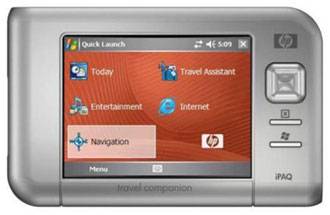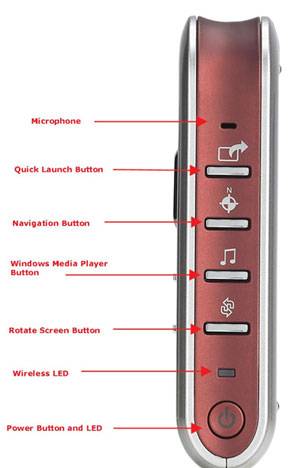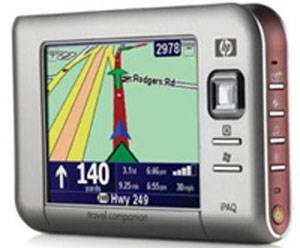Review of HP iPAQ rx5915
Review of HP iPAQ rx5915
Design & Construction
I had been expecting a larger device. In reality, though, the new iPAQ is only a bit larger than my Axim X51v, and smaller than most dedicated GPS receivers like the TomTom One.Side controls, left to right: power, status LED, screen rotate, media player, GPS navigation, Quick Launch

The rx5915 is the first iPAQ designed specifically for a landscape orientation. By default, the system starts up with the directional pad on the right hand side of the screen. If you don't like this orientation, however, among the application buttons along that edge of the case is a button to rotate the screen. Pressing it once switches you to a portrait orientation with the directional pad below the screen and the buttons on the bottom. Keep pressing it, and you'll rotate through all four possible screen orientations, including 180 and 270 degree rotation.
I could be happier with the directional pad. Instead of a more common two-piece affair, where the center action button is physically separate, the new iPAQ's directional pad is all one piece. This, combined with the fact that it's a little squishy, makes it difficult at times to hit the center without also pressing a direction.
One thing that the rx5915 is definitely not equipped for is one-handed navigation. Besides the conspicuous lack of softkeys, the buttons are arranged in such a way that, when the screen is oriented for conventional portrait use, Being also aGPS based unit, this iPAQ comes with a snap-in automotive mount. It's a fairly simple affair, with two flexible axes controlled by screw-knobs, and a large suction-cup base. You can let the iPAQ sit in the holder like a cradle in the default orientation, or you can clamp it in and turn it any which way.
specification of HP iPAQ rx5915
- Processor: 400 MHz Samsung CPU
- Operating System: Windows Mobile 5.1 (Pocket PC) with AKU 2.6
- Display: 3.5 inch, 320 x 240 transmissive/reflective LCD with anti-glare surface.
- Memory: 64 MB RAM; 2 GB flash memory (1.8 GB available to user).
- Expansion: Single SD/SDIO/MMC slot.
- Docking: Single Mini-USB plug.
- Communication: 802.11g Wi-Fi; Bluetooth 2.0.
- Camera None.
- Audio: Internal speaker; 3.5mm headphone jack.
- Size: 4.75 inches long x 3.0 inches wide x 0.65 inches thick; 6.0 ounces.
- Battery: 3.7v, 1700 milliamp-hour rechargeable/replaceable Lithium Ion.
- Input: 5 re-mappable buttons; touchscreen; 5-way directional pad.
- Other_
ports

Processor
This iPAQ is one of the few devices to use Samsung's 400 MHz processor. Previous iPAQs have used under 300 MHz, but recently the line has been almost entirely XScale based.
The processor in the rx5915 scored at 1.3 megaflops of pure computing power. This compares to about 2.0 mflops for my 624 MHz Axim. From this, we can reasonably deduce that the 400 MHz Samsung processor is about as fast as an equivalently clocked XScale PXA270 chip
.
Operating System
Among the customizations to the OS that HP has included is a new alternative launcher, called Quick Launch. It's a simplified launcher screen which provides access to some commonly used applications such as the GPS navigation program, Internet Explorer, games, etcetera. Other preloaded software includes the HP photo viewer, HP's standard Today screen plug-in, and Worldmate, which is a combination of world clock, weather forecast, and currency/unit converter.
Memory
With the listing of 2 GB of internal flash memory in the specs, I suspect that many people are going to be disappointed to open the box and find only around 300 MB available to the user. The reason for this is that 1.5 GB is taken up straight out of the box by a set of hidden files in the "iPAQ File Store" area. These files are, of course, the preloaded TomTom Navigator maps for the United States and Canada (in the North American version of the device, at least--overseas models may vary).
Because the files are hidden, you can't see or delete them with the standard File Explorer, leading to the belief that they're in the device ROM. In fact, they're not. Using a third-party tool such as Resco File Explorer you can find and manipulate them as you like. However, at least on my preproduction device, there were no included discs for the mapping software. Hence, if you ever wanted to use the included maps again, you would have to take special care to back them up, and hope that there aren't any copy-protection mechanisms to stop you from putting them back later.
So the short version of this whole screed is that it is indeed possible to use almost the entire 2 GB of internal memory, but you need to take a few measures in order to do so. Frankly, I'd find it much simpler and more preferable to buy a 4 GB SD card and stick it in the slot if you really want that much extra storage. The risk of damaging the maps isn't worth i
Display

It a most unusual but highly welcome move, the iPAQ's touchscreen comes straight from the factory with an anti-glare coating on the screen. This makes it possible to use the device comfortably even in a bright environment without needing a third-party anti-glare filter like those from PocketPCTechs or Boxwave. The iPAQ's coating also seems to double as a screen protector, protecting the display against most scratches and scuffing. Of course, if you're concerned about longer term wear on your screen, you should still get an additional screen protector of some kind, since the iPAQ's screen covering doesn't appear to be removable or replaceable.
While it's only QVGA resolution, the screen is more than adequate to the task of GPS navigation, along with some video. Maybe I've simply been staring at too many 2.2 and 2.8 inch phone-device screens lately, but the 3.5 inch display in the iPAQ seems quite large and comfortable. It could be larger, of course, or have a VGA resolution, but I'm mostly just happy that HP has produced a device which has an adequate viewable area.
Audio
For reasons unknown in a device designed for GPS the internal speaker faces to the back, where it will be muffled when using the enclosed vehicle mount. It's fairly powerful alone, but once you cover it you get a significant drop-off. Fortunately, you still have the standard 3.5mm headphone jack, so you can wire the system directly to your car stereo if you have the ports and the desire.
.
Communication
No complaints here. Besides the slightly more common 802.11b/g Wi-Fi, the rx5915 is one of the first Pocket PCs to feature Bluetooth 2.0. One of the major specifications of Bluetooth 2.0 is the inclusion of Enhanced Data Rate functionality, which roughly triples Bluetooth speed. However, to take advantage of this you have to have EDR-capable devices on both ends of the connection. Bluetooth 2.0 is increasingly common on new laptops, and some high-end phones, but if you have older hardware you'll have to content yourself with traditional Bluetooth speeds.
Wi-Fi performance was a little problematic to test. Thanks apparently to some of the preproduction software bugs I had trouble getting and staying connected to my Netgear router. For the most part, though, Wi-Fi functions were normal, with adequate speed and response. Though the iPAQ is rated at 802.11g, you probably won't see a performance boost over devices with the older 802.11b,
Audio
For reasons unknown in a device designed for GPS the internal speaker faces to the back, where it will be muffled when using the enclosed vehicle mount. It's fairly powerful alone, but once you cover it you get a significant drop-off. Fortunately, you still have the standard 3.5mm headphone jack, so you can wire the system directly to your car stereo if you have the ports and the desire.
Battery
At a whopping 1700 mAh, the iPAQ has one of the largest standard batteries for current Pocket PCs, all the better to drive its many functions. While I've had a limited amount of time to test the device, I've found its battery performance for most tasks more than adequate. Running a simulated trip in TomTom, with the GPS receiver on and locked, the iPAQ ran for just over four and a half hours before shutting down.
Conclusion
At a suggested the iPAQ rx5915 is a fairly expensive , equivalent to what you'd pay for a good separate handheld, Bluetooth GPS receiver, and large memory card. but once it reaches a decent street price it should be a very nice option for bringing together navigation, multimedia, and Internet access. The iPAQ may not be perfect, but it's certainly a big step forward in the hardware department. If HP can crush the bugs which are so evident on their preproduction units then the rx5915 could very well be the first member of a new class of handhelds bringing consumer-level "killer apps" in a convenient mobile package.
Pros:
* Built-in GPS
* Anti-glare screen
* Large memory
Cons:
* Marginal directional pad
* Charging system irregularities
* Pre-production software bugs